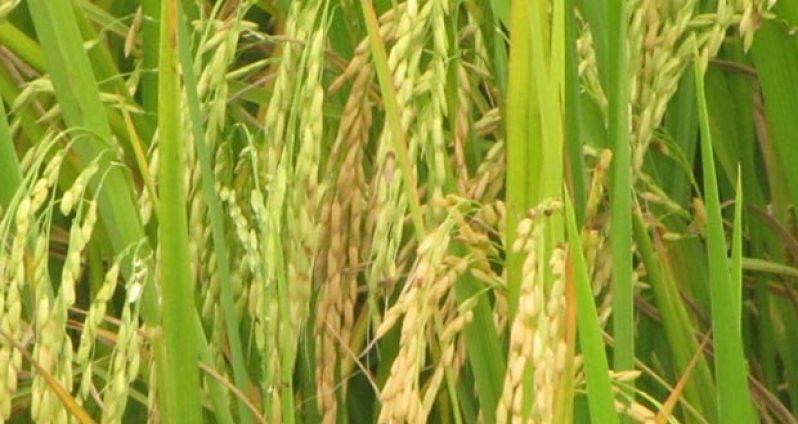Paddy prices fall as production increases
GUYANA’S marked successes in improving both quality and production in the rice sector while laudable, is presenting a challenge for farmers and millers, even as harvesting of the first 2014 crop starts in all the producing regions.

General Secretary of the Rice Producers Association (RPA), Mr. Dharamkumar Seeraj told the Guyana Chronicle that efforts are being made to continuously expand traditional markets, as well as target new ones.
He acknowledged, however, that access to markets is not being expanded fast enough to stay on par with the consistently increasing produce.
Seeraj said this is evidenced by the fact that some 100,000 tonnes of paddy from the last 2013 Autumn crop, remains in stock to be sold.
He explained that, given the supply and demand dynamic, this has resulted in a drop in prices being paid to farmers.
“Last crop, farmers received between $3,800 and $4,200 per bag of paddy. Right now, we have seen a fall in those prices with millers offering between $3,000 and $3,400. Despite this, though, we expect those millers producing parboiled rice to pay $4,000 a bag,” Seeraj said.
He maintained that the current supply and demand dynamic in the industry is one that has the attention of major stakeholders.
Three-pronged strategy
The approach by the Ministry of Agriculture to improving access to markets is centred on a three-pronged strategy of increasing the market share in countries that have agreements with Guyana; re-entering old markets where the country once had a meaningful presence and securing new customers.
“We are currently also looking at Belize,” the RPA General Secretary disclosed.
Several Caribbean and European countries presently import rice from others as well but Guyana sector stakeholders are optimistic that there is an opportunity to secure greater shares in the existing markets.
Seeraj alluded to recent reports on Caribbean export trends and reiterated the potential that can be realised for the local sector.
Oryza Global Rice Quotes, a recognised information source on rice market trends, in a January month end report, said the sole mill in Jamaica completely replaced the United States (U.S.) paddy/rice with imports from Guyana in 2013.
Still, Seeraj contends that, in line with the sector’s three-pronged aim, the Guyanese marketing thrust focuses on dislodging the U.S. as a supplier to the Caribbean Region.
“Our quality and quantity has improved, significantly, as a result of technology and better agronomical practices and we have the capacity to supply the Region. If we can dislodge the U.S. as a supplier, it will be good for Guyana and local rice farmers,” he posited.
The U.S. Department of Agriculture, according to the Oryza report, said Jamaica did not import any paddy/rice from the U.S. in 2013 for the first time in recent history.
Imports from both Guyana and Suriname receive preferential treatment under the common external tariff (CET) for the Community (CARICOM) countries and CET on rice for non-CARICOM nations is 25 per cent, thereby making import from such places comparatively expensive.
Asked about the Venezuelan market, the RPA General Secretary said Guyana’s production surpassing the 500,000 tonnes mark, the neighbouring country now represents a smaller percentage of Guyana’s export market.
“When we were producing just over 300,000 tonnes, Venezuela accounted for over 60 per cent of our exports.
“Now we have gone past that mark with over 500,000 tonnes, of which only 30 per cent was exported to Venezuela. This means that 30 per cent of the exports attracted the best prices,” he said.
Seeraj added that the agreement between Guyana and Venezuela for supply of white rice and paddy for 2014’s first crop is almost accomplished.
“Venezuela is likely to take 200,000 tonnes this crop, 110,000 tonnes of white rice and 80,000 tonnes of paddy,” he said.
Logistical challenges
He underscored, though, that there are “logistical challenges” in supplying this demand, considering the internal political problems Venezuela is now facing.
“We have a CIF (Cost, Insurance and Freight) agreement with Venezuela and there may be a logistical problem in unloading the supply, considering the unrests that are ongoing….with the CIF agreement, we have to pay the related costs until we unload,” he pointed out.
In a press statement, last month, the Ministry of Agriculture assured that the rice trade will not be affected by the unrest, which have claimed the lives of at least 13 people.
The 2014 Spring crop harvesting already commenced, shipment of rice is a critical part of the industry.
The production for 2013 was 535,212 tonnes, which was far above the original target of 413,000 tonnes and reflected 27 per cent more than the 2012 production. The average produced was five tones per hectare.
A further 250,000 tonnes are expected to be harvested this crop, with an average yield of 34 bags per acre.
(By Vanessa Narine)



.jpg)








